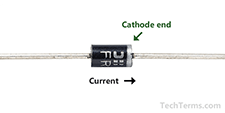Diode
A diode is an electrical component designed to conduct electric current in only one direction. It has two ends (or terminals), each with an electrode of a different charge. The "anode" end has a positive charge relative to the negatively charged "cathode" end. Current naturally flows in the direction from the anode to the cathode.
Diodes commonly serve as switches, allowing or preventing the flow of current. For example, current can be stopped by simply reversing an active diode inside an electrical circuit. Flipping the diode back to the original position will allow electricity to continue flowing through the circuit. Multiple diodes within a circuit can be used as logic gates, performing AND and OR functions.
While current generally flows through a diode in one direction, in some cases the current can be reversed. If the negative voltage applied to a diode exceeds the "breakdown voltage," the current will begin flowing in the opposite direction. The breakdown voltage of a typical diode ranges from -50 to -100 volts, though the amount can be significantly less or more based on the design and materials used in the diode. Some diodes can be damaged by the reverse flow of current, while others are designed to allow current to flow in both directions. Zener diodes, for instance, are designed with specific breakdown voltages for different applications.
Another common type of diode is a light-emitting diode, or LED. Light emitting diodes generate visible light when current passes between the anode and cathode though a space called the p-n junction. The electrical charge in this space produces light in different colors depending on the charge and materials used in the diode.
 Test Your Knowledge
Test Your Knowledge
